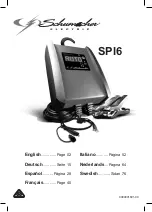
16
5. Position yourself and the free end of the cable (attached to the NEG battery terminal) as far away from the
battery as the cable will allow. Then, WHILE FACING AWAY FROM THE BATTERY, connect the NEGATIVE
charger clamp to the free end of the cable.
Charging Instructions
1. Determine the length of time necessary to charge the battery in Charging Time Instructions, but do not
start the timer.
2. Set all switches and the timer to OFF and connect the charger power cord into an appropriate AC outlet.
3. Set charging voltage, charging rate and any other functions according to Control Setting Instructions.
4. On models so equipped, set the Timer for the desired length of charge time.
WARNING: Battery explosion can injure, and cause property damage! To reduce risk of battery
explosion, do not overcharge a lead-acid battery. Follow disconnection procedure exactly.
5. When charging is complete, turn all charger controls to OFF. Then unplug the charger’s AC power cord
from the AC power source.
6. Disconnect the charger clamp NOT attached directly to the battery first and DO NOT allow the clamp to
touch anything. Then, disconnect the charger clamp attached to the battery terminal.
Reading an Ammeter
The ammeter indicates the charging current being drawn from the charger by the battery. As the battery becomes
more fully charged, the charge rate lessens and the ammeter needle moves toward the lower amp numbers on the
meter. During engine starting, the ammeter will usually peg to the high-amperage end of the meter.
There is no clear-cut way to read an ammeter and determine exactly when charging is complete. At full charge, the
ammeter will still register some current draw (approximately 50% of the charger’s output rating). In many cases,
overcharging can occur if the charger is not disconnected when the battery reaches full charge – or sooner.
Therefore, it is very important that you follow the Charging Time Instructions provided in this manual.
Several battery conditions can also cause the ammeter to appear to indicate a battery near full charge, when in
fact, charging has only begun:
Cold Batteries
(temperatures lower than 32ºF or 0ºC) will begin charging at a low rate of charge. But as
the battery warms up through charging, the charge rate will increase. Then, as the battery charges up, the
charge rate will decrease normally.
WARNING: Battery explosion can injure, and cause property damage! To reduce the risk of battery
explosion, check to make sure a cold battery is not frozen. Battery explosion can result from
attempting to charge a frozen battery.
Sulfated or Deeply-Discharged Lead-Calcium Batteries
require a special activation procedure. See
Pre-Charge Battery Activation, page 14
.
Shorted Batteries
when the battery being charged has a short circuit, the ammeter will peg at the high-
amp end of the scale. If, after 5 to 10 minutes of charging, the needle has not started to move toward
lower amperages, unplug the charger and discontinue charging.
If available, use a voltmeter and read the battery voltage. If the voltage is less than 12.0 Volts for a 12 Volt battery
or less than 6.0 Volts for a 6 Volt battery, plug the charger back in and resume charging. If, after another 15 to 20
minutes, the ammeter has failed to move toward lower amperages, repeat the voltmeter test. If the voltage has not
increased, the battery needs to be serviced or replaced.
CAUTION:
Do not use ammeter to determine when full charge is reached. Failure to comply with this caution could
cause the battery to be damaged from overcharging. The battery could overheat and even explode.
















































